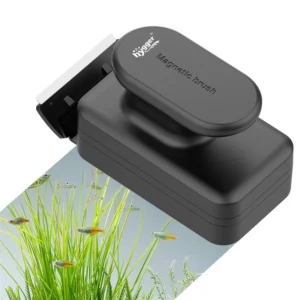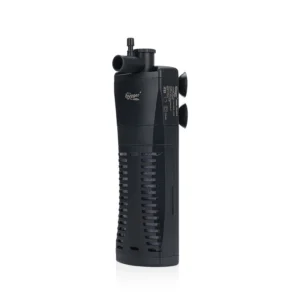Have you ever found planaria in your aquarium? Planaria can regenerate. Specifically, even though a planaria is cut into several pieces, each piece can regenerate into a fully independent one. Sounds tricky, right? Take it easy. This article will walk you through more information about planaria, such as what planaria is and how to remove it.
Content Table
What are planaria in an aquarium?
Belonging to the Planariidae family, planarias are small flatworms. In general, most planarias can reach about 0.5 inches. Besides, featuring a triangular head and two eye spots, their bodies are flat. And brown, white, and dark planarias are commonly found in aquariums. Moreover, planarias prefer living in soil, plants, stones, or other aquarium decorations. However, planarias are harmful to the aquarium and are classified as pests in aquariums. Here are some bad effects of planarias in an aquarium:
- Lower the ornamental value.
- Planaria’s mucus is toxic for most aquarium inhabitants.
- While molting, some planarias harm shrimp.
- Some planarias would eat coral.
On the other hand, where do planarias in an aquarium come from? Usually, planaria would get into your aquarium along with substrates, plants, aquarium creatures, or other aquarium decorations in the form of adult planaria or planaria eggs. Sometimes, it may get into your aquarium with water. Aside from that, planarias would thrive in your tank because of too much waste, including fish feces, uneaten food, and other debris.

Remove planaria from an aquarium
Planarias would produce fast and spread around the aquarium. As a result, you’d better remove them once you find one in your aquarium. This segment will cover some ways to remove planaria from an aquarium.
Remove Manually
First, remove your fish and other aquarium creatures from another tank. Then suck out the planarias on the substrate, rocks, plants, or other objects with an aquarium vacuum. After that, you can clean your aquarium and supplies and refill new water in your tank.
Build planaria traps
Planaria traps can be in various shapes and are usually made of glass. Just prepare a lure in the trap, like mosquito larvae, bloodworms, and other food, to bait planaria entering the trap. Place the trap in your aquarium, and remove it until the planarias are trapped. However, planaria traps may only make sense in planaria population control.
Reduce nutrition source
When you notice planaria in your aquarium, you should check whether there is uneaten food. And then remove the uneaten food with a gravel cleaner. It can limit planaria breeding. The fewer the planaria, the easier to remove.
Add table vinegar
Adding table vinegar can be one solution for most pests in an aquarium. Nonetheless, the vinegar may be damaging to fish or plants. Thus, it is best to remove them from the aquarium before adding the vinegar. After that, you can add a weak vinegar solution to tanks with planaria.
Add table salt
Adding table salt is an effective method. And it is easy. Just mix 1 gram of table salt with 1 liter of water. Nevertheless, the same as table vinegar, table salt may also be detrimental to fish, aquarium creatures, and aquatic plants. Consequently, you should remove them before taking action.
Apply medication
Diverse medications are available to get rid of planaria, for instance, No Planaria Control and other dewormers. Attention here, you should use medications according to the instructions. Otherwise, it might cause stress to your fish or even kill them.
In short, dead planarias would release ammonia, which is harmful to fish and other creatures. Hence, provided that there are fish and other creatures in your tank, it is recommended to remove the dead planarias from the aquarium in time. Additionally, to avoid the risk of harming fish and aquarium creatures, you can remove them ahead of removing planaria.
What aquarium fish eat planaria
In the previous segment, we mentioned some methods to remove planarias in an aquarium. On the other hand, planarias can be a food source for some aquarium fish, such as Angelfish, Rainbowfish, Gourami, and tiger barb. Thus, you can also introduce some fish to deal with the planarias.

Angelfish
Angelfish is a popular freshwater fish, and it belongs to the Cichlidae family. It is an omnivore. Sometimes, it can be aggressive. And it should be kept in a 20-gallon tank at least. Furthermore, angelfish plays a role in palanaria population control, because planarias are one food source for angelfish.
Gourami
Gourami is a freshwater fish, that belongs to the Osphronemidae family. And it is omnivorous. 10 gallons is the minimum tank size for gourami. Additionally, the same as angelfish, gourami only helps to decrease the number of planarias, rather than eliminating them.
Tiger barb
Being one kind of freshwater fish, the Tiger barb belongs to the Cyprinidae family. Also, Tiger Barb is an omnivore. And it is an excellent alternative to feast on planaria. It can be kept in a minimum tank size of 20 gallons. On the other side, tiger barb is semi-aggressive. As a result, it may not be ideal for all aquariums. And you should be cautious when choosing tank mates. For example, betta, gourami, and angelfish tanks are not feasible.
Prevent a planaria outbreak
Although there are remedies for planaria, it is best to prevent its appearance. The following are some suggestions:
- Change the water and clean your fish tanks regularly, including substrate and aquarium supplies cleaning.
- Clean and quarantine the plants, sand, soil, or other aquarium decorations before adding them to your tanks.
- Quarantine new inhabitants for about 2–4 weeks before introducing them to your fish tank.
- Do not overfeed and keep a balanced diet. As for the uneaten food, you should remove it in time.
- For saltwater tanks, you can rinse new objects with coral dip.


Leave a comment